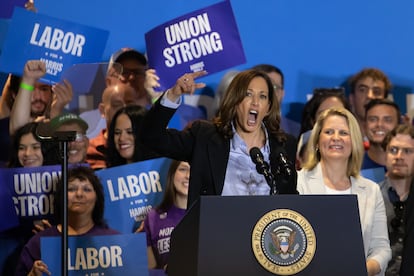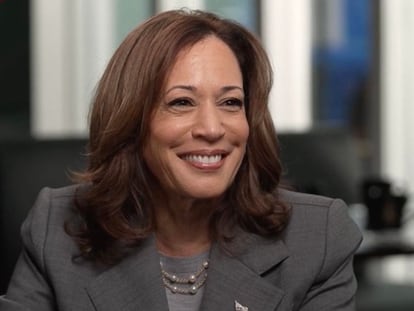Joe Biden enters the fray to help Kamala Harris win working-class vote in key states
The Democratic campaign participated at various Labor Day events while Donald Trump took a break ahead of appearances in swing states later this week


Last year, Joe Biden became the first U.S. president to join the picket lines in support of a strike. Time and again, the current occupant of the White House has described himself as the most pro-union president in the history of his country. Labor organizations had endorsed him before he handed the baton to Kamala Harris. On Monday, Biden took advantage of Labor Day to appear at a first campaign event alongside his vice president since she was proclaimed Democratic candidate, in Pittsburgh (Pennsylvania). Biden is aiming to help Harris with the non-college white worker vote, especially those of union employees. The president will also travel to two other key states this week: Michigan and Wisconsin.
Labor Day unofficially marks the home stretch of the November 5 election campaign, and the president has shown he is willing to travel to seek votes for his vice president. “I’ll be on the sidelines. I’ll do everything I can to help,” he said Monday. The boundary between official and electoral acts is somewhat blurred for incumbent presidents, and vice presidents. Monday’s event was classified as a campaign event, but on Thursday he will go to Wisconsin and on Friday to Michigan with the advantage that acts where Biden sells his administration are considered official, such as the one held with Harris in August outside Washington.
Pennsylvania, Wisconsin, and Michigan form what Democrats have dubbed “the blue wall.” Even if Harris loses Georgia, Nevada, and Arizona, she would win the presidency if she prevails in these three states in the so-called Rust Belt — the U.S. industrial heartland, now somewhat in decline as a result of globalization — and in the rest of the states where Biden won in 2020.
Trump succeeded in 2016 in attracting many of the traditionally Democratic blue-collar voters and won Wisconsin, Michigan, and Pennsylvania, but Biden took back all three states in 2020. Post-election polls point to the incumbent president beating his Republican rival by more than 20 points among union workers.
The president continues to maintain the good relations with union leaders he has cultivated over the years and they supported him when he was a candidate. Several of them have since called for a vote for Harris. Shawn Fain, leader of the United Auto Workers (UAW) union, called for a vote for the vice president at the Democratic convention two weeks ago. Biden also appealed Monday to his roots, having been born in Scranton, Pennsylvania’s eighth-largest city. In his appearances in Wisconsin and Michigan, he is expected to highlight the investments his administration has encouraged and the strong industrial job creation of recent years.
On Labor Day, the Harris-Walz campaign made an effort to participate in events in those three decisive states, while Trump’s paused without explanation. The former president has several campaign events scheduled later this week in the swing states, including a Saturday rally in Wisconsin. In parallel, both are gearing up for the campaign’s next big showdown, the September 10 debate.
On Monday, Walz — whose motorcade was involved in a traffic accident that resulted in several minor injuries — participated in a union festival in Milwaukee, which Biden attended two years ago while campaigning for the congressional elections. Harris, on the other hand, did not hold any large events, but participated in two meetings with reduced seating capacity. The vice president began the day with a rally at a Detroit high school gymnasium, where hundreds of attendees wore yellow T-shirts and carried signs calling for strong unions. The Democratic candidate recalled that one of the first Labor Day parades took place in Detroit some 140 years ago, and that everyone benefits from the work of the labor unions.
Then came the event at a union hall in Pittsburgh alongside Biden, who on this occasion was her opening act as the party’s standing outweighed that of the administration. He was greeted with chants of “Thank you, Joe,” which his vice president joined.
The president, who spoke for about 25 minutes compared to a little over a quarter of an hour for Harris, dedicated most of his speech to defending his administration. He did so with the habit he has acquired lately of sometimes speaking with a sigh and then raising his voice, which does not contribute much to his dialectics.
“Folks, we made a lot of progress and Kamala and I are going to build on that progress and she’s going to build on it,” Biden promised. He called Harris the only “rational” choice for president and repeated what he had said at the Democratic convention, that choosing her as vice president was the “single best decision” of his presidency. He urged union members to vote for her and elect her president: “It will be the best decision you will ever make.”

Corporate protectionism
Harris is seeking a tricky balance between being the candidate of continuity and change, which is even more difficult when she appears on stage next to the president. This time she did not deviate one millimeter from her current boss’s discourse. She even took aim at the opposition to the purchase of U.S. Steel by Japan’s Nippon Steel. “U.S. Steel is a historic American company, and it is vital for our nation to maintain strong American steel companies,” she said, backing Biden’s protectionist policy. “And I couldn’t agree more with President Biden; U.S. Steel should remain American owned and American operated.”
Beyond that, Harris sought to connect with union demands. “Everywhere I go I tell people, look, you may not be a union member, you’d better thank a union member,” Harris said, noting that collective bargaining by unions helped secure the five-day workweek, sick pay, and other key benefits, as well as safer working conditions. “When unions are strong, America is strong,” she said, in a phrase similar to those used by Biden to highlight the role of the unions. “We are very proud to be the most union-friendly administration in the history of the United States,” Harris reiterated.
With a more combative speech than on previous occasions, Harris then moved on to the melee against Trump: “In this election, there are two very different visions for our nation. One is focused on the future, the other on the past,” she said. “As we struggle to move forward. Donald Trump is trying to pull us backward, including back to a time before workers had the freedom to organize,” she insisted to chants of “we’re not going back!” from attendees.
Sign up for our weekly newsletter to get more English-language news coverage from EL PAÍS USA Edition
Tu suscripción se está usando en otro dispositivo
¿Quieres añadir otro usuario a tu suscripción?
Si continúas leyendo en este dispositivo, no se podrá leer en el otro.
FlechaTu suscripción se está usando en otro dispositivo y solo puedes acceder a EL PAÍS desde un dispositivo a la vez.
Si quieres compartir tu cuenta, cambia tu suscripción a la modalidad Premium, así podrás añadir otro usuario. Cada uno accederá con su propia cuenta de email, lo que os permitirá personalizar vuestra experiencia en EL PAÍS.
¿Tienes una suscripción de empresa? Accede aquí para contratar más cuentas.
En el caso de no saber quién está usando tu cuenta, te recomendamos cambiar tu contraseña aquí.
Si decides continuar compartiendo tu cuenta, este mensaje se mostrará en tu dispositivo y en el de la otra persona que está usando tu cuenta de forma indefinida, afectando a tu experiencia de lectura. Puedes consultar aquí los términos y condiciones de la suscripción digital.
More information
Archived In
Últimas noticias
There is as much life left to discover on planet Earth as that which is already known
Dozens presumed dead, around 100 injured in fire at Swiss Alps bar during New Year’s celebration
Is porn for women different from conventional porn? We spoke to those who make it
Cartagena de Indias is sinking: What can the city do to mitigate it?
Most viewed
- Reinhard Genzel, Nobel laureate in physics: ‘One-minute videos will never give you the truth’
- Sinaloa Cartel war is taking its toll on Los Chapitos
- David King, chemist: ‘There are scientists studying how to cool the planet; nobody should stop these experiments from happening’
- Oona Chaplin: ‘I told James Cameron that I was living in a treehouse and starting a permaculture project with a friend’
- The Interoceanic Train, the Mexican alternative to the Panama Canal










































